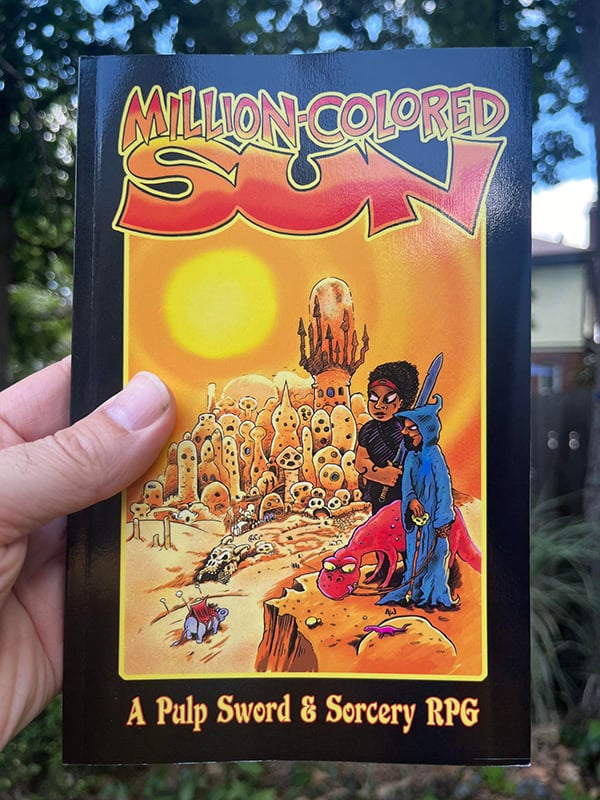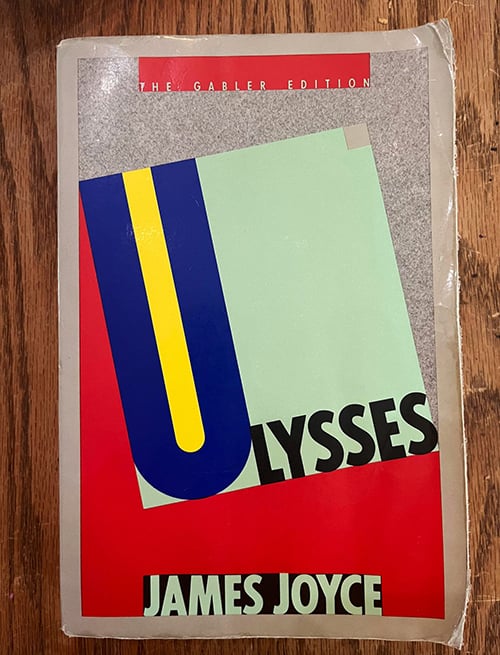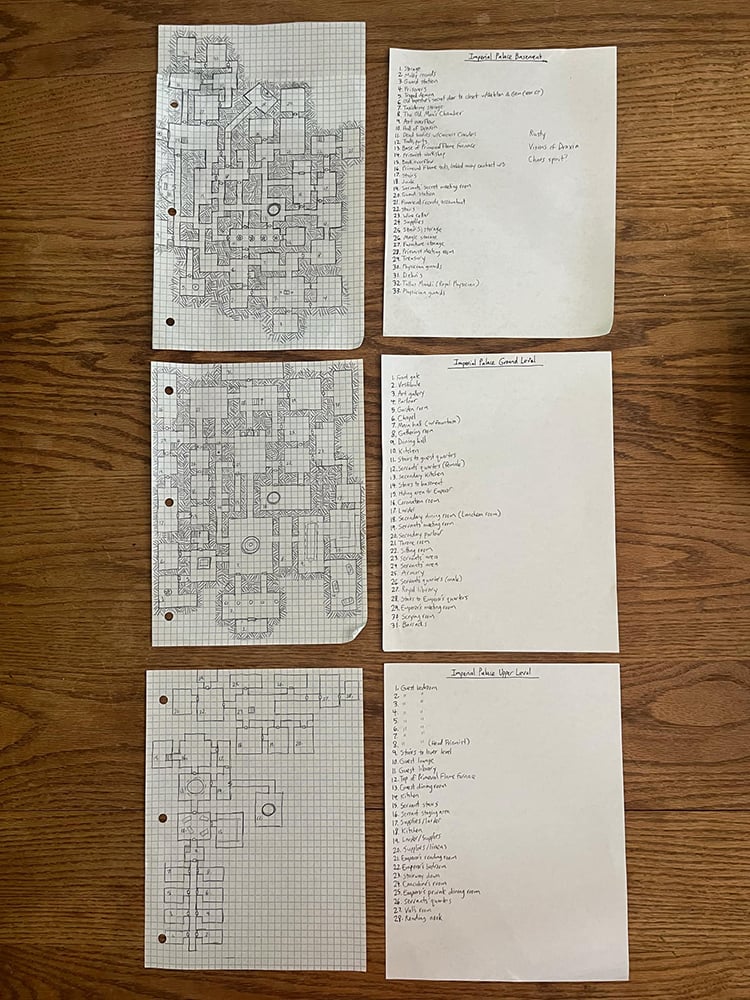Live Every Day Like It's Bloomsday
Somewhere outside the realm of sanity and rational thought lies the Akashic Library, its infinite shelves stretching off past the horizon. What illuminating esoterica will we find there today? Read on, friend, and see . . .
It’s June, and that can only mean one thing . . . time to talk about Ulysses! As you may remember, my friend Tim and I started reading James Joyce’s Ulysses in January, with the goal to finish it by Bloomsday, the famous holiday celebrated each year on June 16. I finished the book on June 15, and on Bloomsday Tim and I met at an Irish pub to discuss the book and have a few drinks.

Also in June, we at Hex Games recently got our first printed copies of Million-Colored Sun. It looks good! Paperback copies are on their way to our Kickstarter backers, with hardcover copies soon to follow. They’re not on sale to the general public yet—we want to get them to our backers first—but when they are, I’ll let you know.

I’ve already started work on my next Kickstarter campaign, for the Lightning Man collected edition, which will launch in July.
And I’ve finished illustrating a short poem that I’m going to print up as a book. It should ALSO be done in July.
My July newsletter’s going to be jam-packed with creative news! So many things!
But right now, I know what you’re here for . .

MY BOOK REPORT ON ULYSSES
Let me get this out of the way first: Ulysses is very hard to read. I traditionally think of myself as someone with good reading comprehension skills and this pushed me to my limits, and beyond. The book was published in 1920, and set in 1904, so there is already a barrier for modern readers, in that Joyce expects you to know song lyrics, political events, and locations that were probably common knowledge, at least in Ireland, when the book was published. Joyce starts the book with a challenging writing style that requires you to constantly pay attention and piece together what’s happening. Then, once you’re getting used to that style, he changes it up, again and again, so that you the reader never have it easy.
I’ve been intending to read this book for a long time, since I was a teenager. The journey began when I bought, based entirely on the description on the back cover, a book called Masks of the Illuminati, by Robert Anton Wilson. The story is about Albert Einstein teaming up with James Joyce, a writer I previously didn’t know anything about, to battle Aleister Crowley. I loved it. What really impressed me about this Robert Anton Wilson fellow was how he experimented with the form of how a novel was written. One chapter was written like a play, one was a series of questions and answers, one was a long string of rambling stream-of-consciousness . . . When I looked into it more, however, I discovered that all of these innovations were copied from Ulysses.
That’s what originally captured my interest; the weird formal experimentation stuff. You can see it just by flipping through the book—Oh, this chapter’s written like a play, neat! And Joyce did all this in 1922? Amazing!
My senior year of high school I bought a copy of Ulysses from Joseph-Beth Booksellers in Lexington, fully intending to read it. I read 102 pages before I lost momentum and put it aside. I didn’t intend to put it aside for more than 30 years, but that’s what happened. Thankfully Tim encouraged me to take that same copy off the shelf and start over.

The high concept of Ulysses is that it’s patterned after The Odyssey, kind of like O Brother, Where Art Thou? Instead of a legendary warrior like Odysseus, you get mild-mannered everyman Leopold Bloom as your hero. Instead of a mythical setting of magic and monsters, you get one day (June 16, 1904) in Dublin, Ireland. The clearest example of how the correspondences work is the cyclops. In The Odyssey, Odysseus and his men are trapped in a cave with the cyclops, a one-eyed giant, until they escape to their ship. As they’re fleeing, Odysseus taunts the cyclops and the cyclops throws a rock at them. In Ulysses, Leopold Bloom is in a bar with an angry one-eyed antisemite who’s ranting at him about how Jews don’t belong in Ireland. Bloom leaves the bar, but as he’s going he gets off a good parting line. The angry one-eyed man throws something at Bloom.
Since The Odyssey begins with Odysseus’s son Telemachus searching for his father, Ulysses begins with young Stephen Dedalus, who is in search of a father figure. Stephen is the protagonist of Joyce’s A Portrait of the Artist as a Young Man, a book that had a profound effect on young me. When I started reading Ulysses the first time, I was eager to read about Stephen, and then lost interest when the narrative focus shifted to Bloom. Old Man Bloom. Friends, in this novel Leopold Bloom is 38 years old. I am more than ten years older than him. That was quite a perspective shift. As you might expect, I no longer find Stephen to be as likeable—I still love the guy, but he is annoying, pretentious, and self-destructive. Come on, Stephen, get over yourself for five minutes! Young people, sheesh.
While I say he’s pretentious, that’s in the way he interacts with people, not that he pretends to be smarter than he is—he’s hella smart, way smarter than me. Stephen is Joyce’s autobiographical stand-in and, like Joyce, he speaks at least five languages fluently and constantly drops quotes from all those languages into his conversation, never bothering to translate anything for those of us who are monolinguistic dullards.
I really was planning on writing about the contents of Ulysses, about what each of the 18 chapters are like, but I seem to have written a lot already just about my relationship with the book. I guess that’s okay, there’s a ton of information online if you want to know more about the book—I recommend this website, particularly the episode guides; they were a big help in making it through the book.
Instead of going into detail, then, I’ll just address the big question: Was the book worth reading? For me, the answer is yes. There were moments I doubted. There was struggle, frustration, rage. There were chapters I didn’t think I would get through. But it all clicked with Chapter 15. That’s the one I’ve mentioned before, that’s written like a play. It’s something like 150 pages long; it could have been published on its own and been a major work of English literature. Anyway, Chapter 15 is the climax of the story, where Bloom and Stephen finally come together, and it is phantasmagorical, filled with hallucinations and fantasies, and in a book that is so focused on formal experimentation, I was shocked to finally come to an emotionally powerful, cathartic moment of human connection. The preceding 14 chapters set it up, everything came together, and I was satisfied. Totally worth it.
When I was 17 I thought, “Someday I want to be a great novelist like James Joyce!” Now I am old, so very old, and it is clear I don’t have anything like a Ulysses in me. The good news is, the world doesn’t really need another Ulysses. The one we’ve got is so vast and rich you could spend your whole life reading and re-reading it.
THE ELECTRIC TEAM
I’ve never mentioned it in this newsletter before, which is an egregious oversight, but from 2015 to 2015 my firstborn child Blu and I co-created and co-wrote a comic called The Electric Team. It was based on the toys we played with when Blu was little, ADORABLE. We hired talented artist Sam Albert to bring the scripts to life, and later Josh Burnett and Jeffrey Johnson illustrated a few stories.

The premise is that it’s a hundred years after an apocalyptic war between magic and science, civilization has collapsed, and there are monsters and tyrants and bandits everywhere. Into this wasteland, a team arises—The Electric Team—determined to defeat 1000 villains and restore civilization.
Man, I love this comic. We did 296 pages and they’re all available online. If I were you, I’d start reading with page 1. I’m not even trying to sell you something—it’s completely free.
We had to bring the comic to a close earlier than intended, for boring life reasons, but we still managed to wrap things up pretty nicely. And hopefully we’ll chronicle some more of our heroes’ adventures some day. Check it out!
RPG HOBBY UPDATE
I run this tabletop role-playing game for my kids and a couple of their friends, and the way it developed, their group needed to sneak into the Imperial Palace. The problem was, I didn’t have a map of the Palace, and I knew it would take a lot of time and effort to make one. So I put off running the game for a few months. Than, as I wrote about in last month’s newsletter, I decided to commit to my hobby without feeling guilty about wasting time.
I didn’t actually know how to make a Palace map, so I started off by copying two maps by esteemed cartographer Joshua LH Burnett, but eventually I got into the swing of it. And I mapped out three levels of Palace, hurray!

The kids snuck into the Palace, the map was very helpful, and a good time was had by all.
BOOKS AVAILABLE THROUGH KINDLE VELLA
There are currently 28 chapters of my science-fiction adventure Armistice Hawkins and the New Architects of Creation available on Kindle Vella. I’m so close to the ending of the story—it used to be fun and easy to work on, but I’ve developed such a mental block. I should be able to get it done this summer . . . but that’s what I said last summer. Pray for me.
You can also read the entirety of my occult detective novel The Lobster-Quadrille there. If you like surreal detective stories, start at the beginning.
BOOKS I'VE READ SINCE LAST TIME
A Deadly Education, Naomi Novik
Avengers: Twilight, Chip Zdarsky and Daniel Acuna
Avengers: Ultron Forever, Al Ewing and Alan Davis
Ulysses, James Joyce
The Guide to James Joyce’s Ulysses, Patrick Hastings
The Last Graduate, Naomi Novik
My friend Meghan recommended A Deadly Education, which is the first book in a trilogy about a boarding school for wizards, but it is very different from the wizard boarding schools you’re thinking of. The school, called the Scholomance, is a hellish nightmare that the kids are trapped in. The school is infested with monsters. Lots of students don’t make it to graduation, and graduation itself has about a 50% survival rate.
I ended up liking it a lot because while there are hordes of monsters, other than that there are no real villains, it’s just about how people in a desperate situation have to work together, or not, to survive. The teen drama and the monster-fighting are seamlessly integrated—you have to make alliances to survive graduation, so who you sit with in the cafeteria is literally a matter of life or death. I just finished the second book in the trilogy and am looking forward to the third.
TV SHOWS I’VE BINGED SINCE LAST TIME
Godzilla: Singular Point
MOVIES I'VE SEEN SINCE LAST TIME
Godzilla: Final Wars
I feel so free, now that I’ve finished Ulysses. I’m hoping to read books and watch movies before we meet again.
Until then, my friend, I hope you are well.
Your Pal,
Leighton